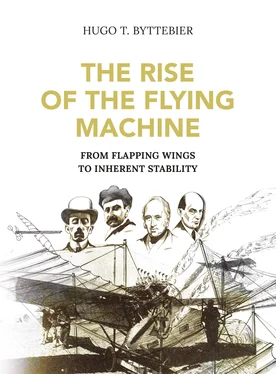Nadar founded a journal with title L’Aéronaute which had a short life due to a lack of subscribers but set the ball rolling. The idea was to single-mindedly promote the art of flying by means of machines heavier than air. Gustave Vicomte Ponton d’Amécourt, one of Nadar’s principal collaborators, had written in 1853, “We will try in vain to solve the problem of aerial navigation as long as we do not suppress the balloon.” Nevertheless, as Navier had calculated that fixed-wing flight was impossible, all minds were set on developing a machine lifted by airscrews.
Another enthusiast, Guillaume Joseph Gabriel de La Landelle, published a book in 1863 with the title Aviation ou Navigation Aérienne (sans ballons) in which the word aviation was used for the first time. This book showed a drawing of a flying vessel that was moved and supported by several horizontal propellers and de La Landelle asserted that by such means 1000 kg could be lifted by a force of 4 hp.
De La Landelle’s flying ship was never built for obvious reasons but it fired the imagination of Jules Verne, who published the best-seller Robur the Conqueror (also translated into English as The Clipper of the Clouds ) describing a flying ship moved by multiple horizontal airscrews as in de La Landelle’s vision.
Ponton d’Amécourt went to the trouble of building an extremely light engine for helicopter use which worked with steam at a pressure of 150 lbs/sq in. from a generator built almost entirely of aluminium, which thereby made its initial appearance as a lightweight metal for light aircraft engines.
The Aeronautical Society
On 12 January 1866, the Aeronautical Society of Great Britain was founded in London, with the Duke of Argyll as president and Francis H. Wenham as one of the founding members.
On 27 January, Wenham read a paper before the Society, entitled On Aerial Locomotion and the Laws by which Heavy Bodies impelled through Air are Sustained . Wenham proposed rigid leading edges of the wings, a high aspect ratio and the use of several superposed planes in order to increase the wing surface without increasing its dimensions and weight in the same proportion. The paper had a great impact on the aeronautical movement in the English-speaking countries.
In the same year an equally important paper was published by Jean-Charles de Louvrié in France with the suggestive title Vol des Oiseaux, équation du travail, erreur de Navier . De Louvrié declared emphatically that Navier’s calculations were wrong, that the bird was similar to the kite “in which the line is replaced by the living force working on the mass (of air) by the propeller” (the wing tips which in a bird act as propellers). This was certainly a new point of view and de Louvrié went on to state that a bird could soar on rising currents of air, determined by the unevenness of the ground and that flight was nothing more than a balancing act.
All this was true, but it led several French enthusiasts, eager to copy the bird’s balancing act, to think along lines that deviated from what Cayley had shown, as will be discussed in a later chapter.
The most important event of the decade was the organization by the Aeronautical Society of the first Aeronautical Exhibition in the world. It opened on the 25 June 1868 at the Crystal Palace in London, and among the seventy-seven exhibits were engines, models and kites.
The Exhibition lasted eleven days, and was especially important because the French were also present. Earlier during the year, the publication L’Aéronaute had been revived by Abel Hureau de Villeneuve and on 23 May a Société Aéronautique et Météorologique de France was constituted on the model of the Aeronautical Society of Great Britain.
The new L’Aéronaute started its publication by reporting extensively on the Aeronautical Exhibition of London. A prize of 100 pounds was to be given for the best engine. Sixteen engines were entered and the prize was unanimously awarded to the steam engine built by John Stringfellow for the Henson experiments referred to above.
The committee, for some mysterious reason, accorded Stringfellow’s engine a power output of one hp. It was later acquired by S. P. Langley for the Smithsonian Institution but on test never approached even the 1/3 hp originally claimed for it. It was also installed in a neat triplane model plane built by Stringfellow but was incapable of making it fly, so the Exhibition produced no artefacts capable of flight.
The French would have liked to submit Ponton d’Amécourt’s aluminium steam engine but Hureau de Villeneuve refused permission to have it fired up, on the grounds that the manometer was lacking. He was criticized for his decision at the time, but he was probably right.
Another steam engine at the Exhibition was built by R. E. Shill, whose “turbine injector power unit” was said to be capable of achieving 1 hp. Shill subsequently collaborated with Thomas Moy, who became bitten by the aeronautical bug at about that time (having exhibited “a mariner’s kite for use in rough weather” at the Exhibition), and subsequently built what was called “Thomas Moy’s Aerial Steamer”. The engine for the first experimental model worked at a pressure of 160 lbs/sq in. and produced three hp for a weight of 80 lbs in 1874.
The model was tested in 1875 but instead of the hoped-for 35 mph take-off speed, only 12 mph was reached and no flight was achieved. Again we see the sanguine response of the pioneers when, after the unsuccessful tests, Moy proposed building a full-size aeroplane with a steam engine of 100 hp “capable of carrying several men” according to Chanute.
It was no wonder that, in one of his reports on the Exhibition to Paris, Hureau de Villeneuve stated sadly that the great enthusiasm aroused in France at the prospect of realizing aerial locomotion in the very near future in 1863 had all but died out and, like Cayley sixty years before, he reflected on the fact that the big problem remained the engine, or rather the lack of a satisfactory one.
In his opinion, it was not a matter of cost and he declared: “At the present stage it does not really matter whether the aero engine consumes alcohol, ether, diamonds or attar of roses. The important thing is to fly at any price.” Economy would be achieved by subsequent practice.
The year 1868 saw another outstanding feat, the invention of the aileron system for controlling the lateral movements of an aeroplane. M. P. W. Boulton registered a patent (No. 392) that year for a system “to prevent [aerial vessels] turning over by rotating on the longitudinal axis”. In his specification Boulton referred to Cayley’s proposals to achieve inherent lateral stability by using a dihedral angle of the wing but he thought that it could become “desirable to provide a more powerful action preventing rotation of the body in this direction”.
The system described (“vanes or moveable surfaces attached to arms projecting from the vessel laterally”), the aileron system as it is called today, was proposed as a safety device in order to redress the aircraft if, for some reason it should begin to roll as a result of a gust of wind or an upset balance. The purpose of the invention was to ensure that “the balance of the vessel is redressed and its further rotation prevented”.
This was aileron action as it is used on the great majority of modern aeroplanes although no mention was made for its use in order to make a turn. That had not yet entered the vision of the aviation pioneers and would come much later.
Thus, the modern aeroplane was slowly taking shape. A light and powerful engine, fixed and rigid wings of high aspect ratio, a horizontal and vertical movable rudder at the rear, ailerons for controlling unwanted rolling movements were contemplated in theory before the end of the 1860s.
Читать дальше












